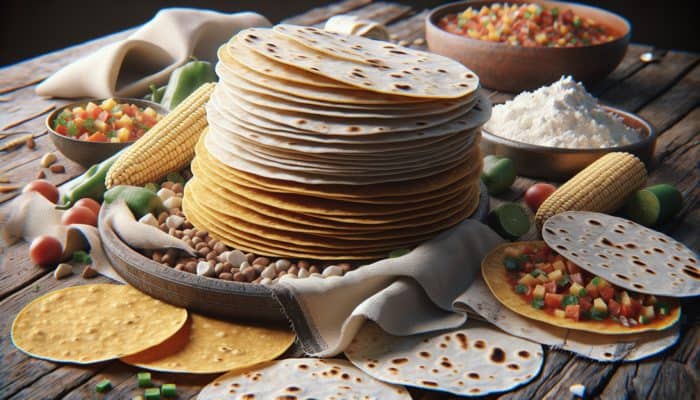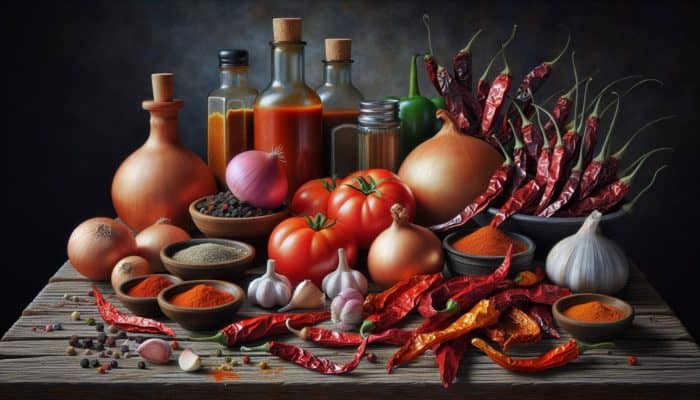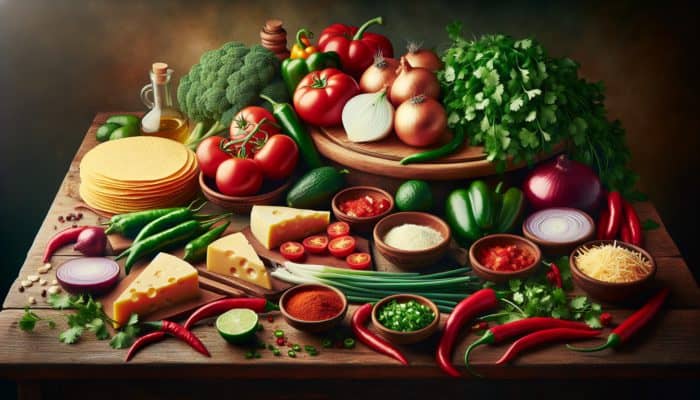Discover Essential Ingredients for Authentic Enchiladas
Exploring the Best Types of Tortillas for Enchiladas

How to Cook Authentic Mexican Enchiladas: The foundation of any authentic enchilada begins with the choice of tortillas. Traditionally, corn tortillas are favoured for their distinct flavour and texture, which lend an earthy quality to the dish. However, flour tortillas have gained popularity in various regions, especially for those who prefer a softer, chewier texture. Each type serves a purpose based on personal taste and dietary needs. Corn tortillas are gluten-free and provide a traditional taste, while flour tortillas can hold more filling and are less likely to break during rolling. When selecting your tortillas, consider factors such as nutrition, dietary restrictions, and desired mouthfeel.
Freshness is key; opt for tortillas that have been prepared locally or, if possible, make your own from masa harina. The quality of the tortilla can significantly influence the overall experience of the enchiladas. If using store-bought, check the ingredient list for authenticity—look for products that use just corn, water, and lime. This simple ingredient profile ensures that you’re getting a taste that aligns with traditional Mexican cuisine.
Selecting the Perfect Cheese for Your Enchiladas
The choice of cheese in your enchiladas can elevate the dish from ordinary to extraordinary. Common options include queso fresco, which is crumbled over the top for a creamy, salty bite, cheddar, which offers sharpness, and Monterey Jack, renowned for its melting qualities. Each type brings its own unique flavour profile to the table. When selecting cheese, consider both flavour and meltability, as each contributes to the dish's overall texture and taste.
For a truly authentic experience, look for artisanal cheeses that are made following traditional methods. Some may even incorporate local ingredients or specific regional techniques, thereby providing an even deeper connection to Mexico's culinary traditions. Combining multiple cheeses can also lead to a complex flavour, so don’t hesitate to experiment with different combinations to find what delights your palate.
Exploring Protein Options for Your Enchiladas
Enchiladas are incredibly versatile, offering a range of protein options to cater to various dietary preferences. Traditional choices include shredded chicken or beef, which can be seasoned with spices to enhance their flavour. For those seeking vegetarian alternatives, consider using beans, lentils, or a medley of sautéed vegetables like zucchini, bell peppers, and mushrooms. These options not only provide nutritional balance but also contribute to the overall flavour profile of the dish.
Regional variations can influence protein choices, too. For instance, in coastal areas, seafood like shrimp or fish is often incorporated, adding a fresh twist to the traditional recipe. When selecting your protein, consider how the flavours will blend with your sauce and toppings, ensuring a harmonious dish. Preparation methods also matter; slow-cooking meats can infuse them with spices and moisture, while grilling vegetables can enhance their natural sweetness, making each bite a delight.
Choosing the Ideal Sauce for Your Enchiladas

The sauce is perhaps the most critical component of enchiladas, with both red and green chilli sauces being traditional options. Red sauce, often made from dried red chillies, provides a rich, smoky flavour. In contrast, green sauce, typically made from tomatillos or green chillies, offers a tangy, bright taste. Your choice should align with the flavour profile you desire for your enchiladas, as each sauce can dramatically alter the experience.
Consider the heat level of your sauce as well; some chillies are milder than others, and pairing the right sauce with your protein can enhance or mute certain flavours. A well-balanced sauce should complement the protein and not overwhelm it. When making your sauce, taste frequently and adjust the seasoning and heat to your liking. A sauce that is too spicy can overshadow the other ingredients, while a bland sauce can leave your dish lacking in depth.
Fresh Toppings and Garnishes to Enhance Your Enchiladas
To elevate your enchiladas, fresh toppings and garnishes play a pivotal role. Ingredients such as finely diced onions, fresh coriander, and a squeeze of lime add a burst of brightness and flavour that can brighten the dish. Additionally, creamy components like sour cream or avocado offer a rich contrast to the spice of the enchiladas. These toppings not only enhance the flavour but also provide textural contrast that makes each bite exciting.
Consider the balance of textures and flavours when choosing your garnishes. A sprinkle of crumbled queso fresco can add a creamy texture, while diced tomatoes can offer a juicy crunch. Tailoring these elements to your taste can transform simple enchiladas into a show-stopping dish. Don’t shy away from experimenting with various garnishing techniques, whether it’s a drizzle of crema for added richness or a scattering of pomegranate seeds for a pop of colour and sweetness.
Mastering the Preparation of Enchilada Sauce
Key Ingredients for a Traditional Enchilada Sauce

The heart of any authentic enchilada lies in its sauce. A traditional enchilada sauce typically consists of essential ingredients, including tomatoes, dried chillies, garlic, and various spices. The tomatoes provide a luscious base, while the chillies contribute heat and depth. Choosing the right type of chilli is paramount; options like ancho, guajillo, or chipotle can add layers of flavour, ranging from sweet and smoky to spicy and fiery.
Garlic and onions are also crucial for building a flavourful foundation, imparting aromatic qualities that enhance the overall sauce. Spices such as cumin, oregano, and even a touch of cinnamon can provide complexity that rounds out the flavour profile. Adjust the heat level to your taste by controlling the number and type of chillies used. The beauty of making your sauce lies in its flexibility; feel free to play around with ingredient proportions until you find the balance that excites your palate.
Effective Cooking Techniques for Perfecting Sauce Consistency
When it comes to achieving the ideal sauce consistency, the cooking techniques employed can make all the difference. Two primary methods—simmering and blending—offer distinct advantages. Simmering allows flavours to meld together, creating a rich, cohesive sauce. This slow cooking method helps to soften the chillies, making them easier to blend, while also concentrating their flavours.
Alternatively, blending the sauce can provide a smooth and creamy texture, perfect for those who prefer a more refined sauce. If using dried chillies, consider toasting them lightly in a dry skillet before adding them to the sauce; this technique can intensify their flavour. The choice between simmering and blending ultimately depends on the desired texture; for a chunky sauce, consider simmering for a longer period, while a quick blend can yield a smoother finish. Regardless of the method, always taste and adjust your seasoning as you go to ensure maximum flavour.
How Can You Thicken the Enchilada Sauce Effectively?
To achieve the ideal consistency for your enchilada sauce, various methods can be used to thicken the sauce. Here are some effective techniques:
- Roux: A mixture of flour and fat cooked together can create a thick base.
- Reduction: Simmering the sauce uncovered allows excess liquid to evaporate, naturally thickening the sauce.
- Cornstarch Slurry: Mixing cornstarch with water and adding it to the simmering sauce can quickly thicken it.
- Mashed Beans: Pureed beans can be blended into the sauce, adding body and creaminess.
- Vegetable Puree: Adding pureed cooked vegetables, such as potatoes or squash, can also enrich and thicken the sauce.
- Chia Seeds: Ground chia seeds can absorb liquid and thicken without altering flavour.
Experimenting with these methods allows you to find the perfect thickness that suits your taste preferences. Always remember to incorporate thickeners gradually, giving the sauce time to adjust before adding more.
Expert Techniques for Assembling Your Enchiladas
Layering the Tortillas for Optimal Flavour
The assembly of your enchiladas is a crucial step in ensuring each bite is full of flavour and texture. Begin by laying down a base of sauce in your baking dish—this not only prevents sticking but also infuses the tortillas with flavour. Next, soak each tortilla briefly in the sauce to soften it, making it easier to roll. It’s essential to layer the tortillas properly; start with a tortilla, followed by a portion of your protein filling and a sprinkle of cheese. Then, fold it tightly to secure the filling within.
Repeat the process for multiple layers if desired; however, be careful not to overload with filling, as this can lead to a messy end product. The key is to achieve a balance between filling and tortilla, ensuring that each enchilada retains its shape while being packed with flavour. Depending on your preferences, you may also choose to alternate fillings for a variety of flavours throughout the dish.
What Is the Best Way to Roll Enchiladas for Success?
Rolling enchiladas properly is vital for maintaining their integrity during baking. The best way to roll enchiladas is to tightly wrap the tortilla around the filling, ensuring that it stays sealed throughout the cooking process. To achieve a good roll, use a spoon to help guide the filling and prevent it from escaping. Begin by placing the filling towards one end of the tortilla, leaving space on the sides to avoid overflow.
- Warm the tortillas to make them pliable.
- Use a spoon to scoop the filling and place it towards the end of the tortilla.
- Fold in the sides before rolling to secure the filling.
- Roll tightly but not too tightly to avoid tearing.
As you roll, keep the edges tucked to ensure a neat presentation. If you find that your tortillas frequently break or tear, consider lightly frying them in oil for a few seconds to make them more pliable. This technique also adds a delightful flavour and texture to the final dish.
Topping and Baking Your Enchiladas to Perfection
Once your enchiladas are assembled, it’s time to top and bake. Generously cover the rolled enchiladas with your chosen sauce, allowing them to soak up the flavours and prevent them from drying out in the oven. After your sauce layer, sprinkle an ample amount of cheese on top; this will melt beautifully during baking and create a delightful crust.
Preheat your oven to a moderate temperature, typically around 180°C (350°F). Bake the enchiladas until the cheese is melted and bubbly, typically around 20-25 minutes. For a golden finish, consider broiling briefly at the end—keep an eye on them to prevent burning. The result should be enchiladas that are hot throughout, with a beautifully melted cheese topping that invites you to dig in.
Serving and Garnishing Enchiladas for a Stunning Presentation
The presentation of your enchiladas can elevate the dining experience. Once out of the oven, allow them to cool slightly before serving. This resting phase allows the flavours to settle and makes them easier to plate. Garnish with freshly chopped coriander, diced tomatoes, and a dollop of sour cream for added richness. A squeeze of lime over the top can enhance the dish, bringing out the flavours of the sauce and fillings.
Consider the overall dish composition—how the colours and textures of the garnishes complement the enchiladas. A vibrant presentation not only stimulates the appetite but also showcases the effort put into creating the meal. Whether it’s a casual family dinner or a festive gathering, the way you serve enchiladas can make a memorable impression on your guests.
Expert Insights into Cooking Authentic Mexican Enchiladas
Include Real-World Examples of Successful Enchilada Recipes
Real-world examples provide a wealth of insight into crafting delicious enchiladas. Numerous chefs and home cooks alike have shared their recipes, showcasing unique ingredient combinations that resonate with diverse audiences. For instance, a popular recipe features a spicy chicken filling paired with a creamy green sauce, while another highlights a rich beef filling with a robust red sauce. These examples demonstrate the versatility of enchiladas and how they can adapt to various tastes and cultural influences.
- Chicken enchiladas with tomatillo sauce.
- Black bean and cheese enchiladas with mole sauce.
- Seafood enchiladas topped with a spicy red sauce.
- Vegetarian enchiladas with roasted vegetables and green sauce.
Showcasing these recipes not only inspires creativity but also illustrates how traditional flavours can be reimagined to suit modern palates. The key is to use quality ingredients and to honour the traditional preparation methods while allowing for personal flair. When sharing your creations, consider documenting the process with photos or videos to inspire others in their culinary journey.
Provide Actionable Steps for Flavour Enhancement in Enchiladas
To take your enchiladas to the next level, focus on specific steps for flavour enhancement. Begin by marinating your proteins with spices, citrus, or herbs for a few hours before assembly. This allows the flavours to penetrate the meat, creating a more robust taste. Additionally, consider layering flavours by incorporating different spices at various stages of preparation; for instance, adding cumin to the filling and oregano to the sauce can create a harmonious blend.
Please don’t underestimate the power of toasting your spices before adding them to the dish. This technique releases their essential oils, enhancing their flavour. When preparing sauces, taste frequently and adjust the acidity with lime juice or sweetness with a touch of sugar to find the perfect balance. The goal is to build flavour layers that develop complexity, ensuring that each bite explodes with taste.
Offer Expert Analysis on Common Mistakes in Enchilada Preparation
Several common pitfalls can occur during enchilada preparation, which may compromise the final product. One frequent mistake is using overly dry or stale tortillas, which can lead to breakage and a less enjoyable texture. Always ensure your tortillas are fresh, or consider warming them to make them more pliable. Another common oversight is neglecting to season the filling adequately; without proper seasoning, even the highest-quality ingredients can fall flat.
Additionally, sauce consistency is crucial; a sauce that is too thick can dry out the enchiladas, while one that is too thin can lead to a soggy dish. Striking the right balance is imperative for achieving that satisfying texture. Finally, be cautious about overfilling the enchiladas. Too much filling can cause them to burst during baking, ruining the presentation. Following these tips can help you create enchiladas that are not only flavourful but also visually appealing.
Share Tips on Traditional Mexican Cooking Techniques
Authentic cooking techniques are invaluable for preparing traditional enchiladas. One such method involves making your own masa from nixtamalised corn, which can significantly elevate the taste of your tortillas. This process can seem daunting, but it’s worth the effort for those seeking authenticity. Additionally, consider using traditional cooking vessels, such as a comal for grilling tortillas or a molcajete for grinding spices, to connect more deeply with the cooking process.
Another tip is to incorporate regional ingredients that are reflective of the area you are inspired by. For example, if you're making enchiladas from Oaxaca, consider including local cheese and chillies that are native to the region. Embracing these authentic techniques not only enhances the flavour of your enchiladas but also pays homage to the rich culinary traditions of Mexico. By delving into these methods, you can create a dish that is truly representative of its cultural heritage.
What Are the Benefits of Making Enchiladas at Home?
Cost-Effectiveness of Homemade Enchiladas
Making enchiladas at home can be a remarkably cost-effective choice compared to dining out. Many ingredients required for enchiladas are affordable and readily available, making it easy to prepare a delicious meal for a group without breaking the bank. For instance, tortillas, beans, and seasonal vegetables can often be sourced inexpensively, while proteins can be purchased in bulk for added savings. This approach not only allows for financial flexibility but also encourages creativity in using leftovers or seasonal produce.
Cooking at home also means you can control portion sizes, reducing food waste and ensuring that each meal feels satisfying without excessive leftovers. Additionally, when you make enchiladas from scratch, you can adapt the recipe to suit your budget, choosing more economical proteins or seasonal vegetables that keep costs down. Over time, these savings can significantly add up, making homemade enchiladas a delightful and economical dining option.
Enjoying Customisation Options for Your Enchiladas
One of the most enjoyable aspects of cooking enchiladas is the customisation options available. This dish allows you to cater to a variety of dietary preferences and restrictions, whether it’s gluten-free, vegetarian, or vegan. For instance, using gluten-free tortillas or substituting traditional cheese with plant-based alternatives can make enchiladas more accessible to a wider range of individuals. Additionally, you can experiment with different flavour profiles by incorporating various fillings and sauces, catering to personal tastes.
The possibilities are virtually endless; consider trying fillings that reflect local cuisine or experimenting with fusion flavours that draw inspiration from other culinary traditions. This flexibility enables you to create enchiladas that are uniquely yours while still honouring the essence of the traditional dish. Such a personal touch not only enhances your enjoyment but also engages your guests by offering them a meal tailored to their preferences.
What Nutritional Value Do Enchiladas Offer?
Enchiladas can offer a well-rounded nutritional value, making them a wholesome meal option. By incorporating a balance of proteins, vegetables, and dairy, you can create a dish that is satisfying and nutritious. For instance, a filling made with lean chicken or beans provides protein, while adding vegetables like spinach or bell peppers boosts fibre and vitamins. The inclusion of cheese can contribute calcium and healthy fats, ensuring a balanced meal.
Moreover, you can easily adjust the nutritional profile of your enchiladas by opting for healthier ingredients, such as whole-grain tortillas or low-fat cheese. This adaptability allows you to maintain flavour while promoting healthier eating habits. When prepared with attention to ingredient quality, enchiladas can serve as a nutrient-dense meal that aligns with various dietary goals, providing energy and satisfaction.
How Can You Serve Enchiladas for Different Occasions?
Creating a Casual Family Dinner with Enchiladas
Enchiladas are an excellent choice for casual family dinners, as they are both hearty and comforting. Their versatility allows for quick preparation; you can prepare them in advance and bake them just before mealtime. Serve enchiladas with classic sides like rice and beans to create a complete meal, ensuring that everyone leaves the table satisfied. The communal nature of enchiladas encourages sharing, making them perfect for family gatherings.
Consider setting up a toppings bar where family members can personalise their enchiladas with garnishes like sour cream, shredded cheese, or fresh vegetables. This interactive approach not only adds an element of fun but also allows for individual preferences to shine. The ease of assembly and adaptability of flavours make enchiladas a go-to option for busy evenings or relaxed family nights at home.
What Are Some Elegant Presentation Ideas for Enchiladas?
For special occasions, enchiladas can be elevated with elegant presentation ideas that impress guests. Start by selecting a beautiful serving dish that showcases the vibrant colours of your enchiladas. Consider layering the enchiladas in a manner that highlights their textures, with fresh garnishes artfully arranged on top. Adding elements like avocado slices, edible flowers, or a colourful drizzle of crema can create visual interest and sophistication.
Additionally, serving enchiladas on individual plates allows for a more refined dining experience. Pair the dish with complementary sides, such as a fresh salad or grilled vegetables, to provide a balanced plate. The key to an elegant presentation lies in the attention to detail; incorporating seasonal ingredients or decorative garnishes can turn a simple dish into a culinary masterpiece that wows your guests.
Making Enchiladas for Large Gatherings and Parties
Enchiladas shine at large gatherings and parties due to their ability to be prepared in bulk. When hosting an event, consider making a variety of enchiladas to cater to different tastes and dietary preferences. Setting up a DIY topping bar allows guests to customise their enchiladas according to their liking, ensuring that everyone finds something they enjoy. This interactive dining experience fosters a sense of community and engagement among guests.
To streamline the serving process, prepare your enchiladas ahead of time and keep them warm in the oven until guests arrive. Having multiple trays with different fillings and sauces not only adds variety but also allows for easier serving. Enchiladas are filling, making them an ideal option for satisfying hungry guests, while their versatility ensures that they can accommodate various dietary needs.
Quick Weeknight Meals with Enchiladas
On busy weeknights, enchiladas can transform into quick weeknight meals with a little planning. Using pre-made sauces or leftover proteins can significantly reduce preparation time, allowing for a wholesome dinner in under an hour. Consider utilising frozen or fresh veggies along with your favourite fillings to expedite the cooking process while maintaining flavour and nutrition.
Assemble the enchiladas in advance and store them in the fridge until you are ready to bake, making it easy to put dinner on the table during hectic evenings. Pair with a simple side salad or some steamed vegetables for a complete meal that satisfies the whole family. The adaptability of enchiladas makes them the perfect weekday option, combining convenience with incredible taste.
Essential Tips for Storing and Reheating Enchiladas
Implementing Proper Storage Techniques for Enchiladas
To ensure your enchiladas stay fresh, it’s essential to employ proper storage techniques. Start by allowing the enchiladas to cool completely before transferring them to airtight containers. If you anticipate keeping them for more than a day, consider freezing them. In this case, wrap individual portions in plastic wrap before placing them in a freezer-safe container to prevent freezer burn. Label the containers with dates to keep track of freshness.
When storing enchiladas, consider separating the sauce from the tortillas if possible to maintain their texture. This can help prevent sogginess and ensure that they retain their appealing bite when reheated. Stored correctly, refrigerated enchiladas can last up to 5 days, while frozen ones can be kept for up to 3 months, making them a convenient meal option for later enjoyment.
Effective Reheating Methods for Leftover Enchiladas
When it comes to reheating enchiladas, the method you choose can significantly impact their texture and flavour. The oven is the best option for maintaining the dish's integrity, as it allows for even heating and preserves the crispy edges. Preheat your oven to around 180°C (350°F) and cover the enchiladas with foil to prevent them from drying out. Bake for approximately 20 minutes or until heated through.
If you're short on time, the microwave is a quick alternative, though it may result in a softer texture. Place the enchiladas on a microwave-safe plate, cover with a damp paper towel, and heat in short intervals until warm, being careful not to overcook. Regardless of the method, ensure that the enchiladas reach an internal temperature of 75°C (165°F) to ensure food safety.
How Long Can You Store Enchiladas Safely?
Understanding how long you can store enchiladas is crucial for food safety and quality. When refrigerated, enchiladas can last up to 5 days without compromising their taste or safety. If you choose to freeze them, they can be kept for up to 3 months, allowing for convenient meal options at a later date. To maximise freshness, always ensure they are stored in airtight containers or well-wrapped to prevent exposure to air, which can lead to freezer burn.
When ready to enjoy, ensure that you reheat them thoroughly before serving. A good rule of thumb is to check for an internal temperature of 75°C (165°F) to ensure they are safe to eat. This knowledge will enable you to enjoy your enchiladas at your leisure while maintaining their flavour and texture.
Innovative Variations and Innovations in Enchilada Recipes
Exploring Exciting Different Fillings for Enchiladas
One of the most exciting aspects of making enchiladas is the opportunity to explore different fillings. While traditional choices like chicken and beef are beloved, consider branching out by incorporating seafood such as shrimp or fish, or even exotic vegetables like butternut squash or jackfruit to create unique flavour profiles. Each filling brings its own character to the dish, allowing you to create a variety of enchiladas that cater to different tastes.
Furthermore, consider combinations that marry influences from other cuisines. For example, Asian-inspired enchiladas featuring marinated tofu or kimchi can offer an exciting twist. Adding local ingredients can also enhance the culinary experience, introducing flavours that resonate with your personal palate or regional cuisine. The beauty of enchiladas lies in their adaptability; embrace creativity and let your culinary imagination run wild!
Creating Unique Sauce Variations for Enchiladas
The sauce is a defining element of enchiladas, and exploring sauce variations can completely transform the dish. While red and green sauces are traditional, consider experimenting with mole, a rich, complex sauce that combines chocolate with spices, or even a creamy white sauce infused with herbs. Each sauce brings its own unique flavour, allowing you to tailor your enchiladas to suit different culinary themes.
Don’t hesitate to blend different chillies to create a custom sauce that balances heat and flavour. Combining sweet and smoky elements can lead to delightful discoveries that excite the palate. The versatility of sauces offers countless possibilities for innovation, inviting you to create enchiladas that reflect your personal taste and the culinary traditions you wish to explore.
What Are Some Modern Twists on Traditional Enchiladas?
Modern cooking has given rise to a myriad of twists on traditional enchiladas, incorporating contemporary ingredients and cooking techniques. For instance, vegan enchiladas made with cashew cream or lentil filling demonstrate how to adapt classic recipes to align with modern dietary preferences. Gluten-free options are also increasingly popular, utilising alternative flours or vegetables as wrappers.
Consider introducing creative cooking methods, such as grilling or air frying, for a unique texture and flavour. By leveraging new culinary trends, you can refresh the classic enchilada dish while retaining its essence. Embracing these innovations ensures that enchiladas remain relevant and exciting in today’s diverse food landscape, encouraging culinary exploration and creativity.
Frequently Asked Questions About Enchiladas
Can I use flour tortillas instead of corn tortillas for enchiladas?
Yes, you can use flour tortillas instead of corn tortillas for enchiladas. While corn tortillas are traditional, flour tortillas provide a softer texture and may be easier to work with for some individuals.
What is the best way to keep enchiladas from getting soggy?
To prevent enchiladas from getting soggy, ensure that you do not overload them with sauce when assembling. Additionally, consider preheating your tortillas and using a thicker sauce for better texture retention.
How can I make enchiladas spicier?
To make enchiladas spicier, incorporate hotter chillies in the sauce, such as serrano or habanero. You can also add chopped jalapeños into the filling for an extra kick.
Are enchiladas healthy?
Enchiladas can be healthy when made with fresh ingredients and balanced fillings. Incorporating lean proteins, plenty of vegetables, and whole-grain tortillas can boost their nutritional value.
Can I freeze enchiladas?
Yes, enchiladas can be frozen. Wrap them tightly in plastic wrap and store them in airtight containers. They can last up to 3 months in the freezer.
How do I reheat frozen enchiladas?
To reheat frozen enchiladas, place them in the oven at 180°C (350°F) and heat until they are heated through, typically 30-40 minutes. Cover with foil to prevent drying out.
Can I make enchiladas ahead of time?
Yes, enchiladas can be assembled ahead of time and stored in the refrigerator until ready to bake. This makes for a convenient meal option when entertaining or during busy weeknights.
What sides go well with enchiladas?
Sides that pair well with enchiladas include Mexican rice, refried beans, guacamole, or a fresh salad. These accompaniments complement the flavours of the enchiladas beautifully.
Is there a vegetarian option for enchiladas?
Yes, vegetarian enchiladas can be made using ingredients like beans, cheese, or a variety of vegetables such as spinach, zucchini, and mushrooms, offering a delicious alternative to meat.
What type of cheese is best for enchiladas?
Cheeses like queso fresco, Monterey Jack, or cheddar are excellent for enchiladas. Each provides unique flavours and melting qualities that enhance the overall dish.



Ah, the great tortilla debate—a timeless classic akin to whether pineapple belongs on pizza or if dogs truly are better than cats (they are, in case you were wondering). I appreciate your deep dive into the tortilla realm!